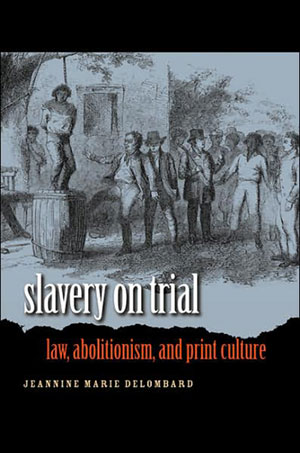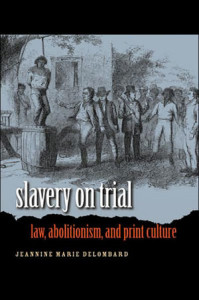Print the (New) Legend!

“When the legend becomes fact, print the legend.”
—The Man Who Shot Liberty Valence
Despite the fact that print culture, abolitionism, and the American legal system matured together during the nineteenth century, they are strange bedfellows in many scholarly studies. For print scholars, slavery and abolitionism remain at the margins of “book history.” For many abolitionist scholars, exemplary antislavery reformers remain those “passionate outsiders” who defined themselves against mainstream institutions, including those of politics and law. As Jeannine DeLombard shows in her wide-ranging and thoroughly researched study, print, abolitionism, and the law formed lasting bonds in the early republic. “During the three decades preceding the Civil War,” DeLombard writes at the outset of her indispensable book, “slavery was on trial in the United States” (1). No mere courtroom drama, abolitionists’ case before the “bar of public opinion” had lasting consequences for northern liberty, southern defenses of bondage, and the coming of the Civil War.
DeLombard begins Slavery on Trial by placing antebellum abolitionism in a dynamic historical context. By the time her study gets rolling in the 1830s and 1840s, new-style abolitionists like Garrison and Douglass had already shed their movement’s elite beginnings by focusing intensely on print culture. Realizing that immediate abolitionists formed a small minority, new-style reformers turned to mass media to make their case. DeLombard argues that abolitionists had to first “decriminalize” their movement before the public at large. At the same time, antebellum abolitionists came to see legalistic discourse—including metaphors of trials, prosecutions, eyewitness testimony, and cross-examinations—as an essential means of battling bondage in the public arena.
Thus did the antislavery movement use American print culture to create a national trial on slavery. As DeLombard observes, both the adversarial model of American law that came into vogue during the early nineteenth century and the discourses long associated with criminal litigation inspired antebellum abolitionists to become the architects of a courtroom-like drama that condemned slaveholders and their apologists. “[A]bolitionists’ trial trope facilitated a radical reconceptualization of civic participation in America,” she notes. “By patterning their behavior on the personae of the criminal trial, those who approached the bar of public opinion challenged prevailing hierarchies of race, gender, class, and condition by modeling new forms of civic presence” (222).
At the heart of abolitionists’ legalistic print strategy was the notion that the American people could upend formal decisions rendered in courts of law. In prosecuting their case, DeLombard comments wittily, abolitionists “effected a change of venue” from courts to print (18). This “extralegal” maneuvering was far from evidence of abolitionists’ anti-institutional thinking. Rather, antislavery reformers viewed print as a critical part of the civic realm—an essential institution. Moreover, this brand of popular constitutionalism—the view that the people out of court could render a verdict as powerful as any judge—borrowed from a tradition of popular sovereignty dating to the eighteenth century. Jacksonian democracy abetted popular constitutionalism by not only emphasizing the power of the people but by resurrecting Americans’ age-old fears of arbitrary figures (namely recalcitrant judges) foiling liberty. DeLombard shows that well before the famous fugitive slave trials of the 1850s, fears of “atrocious judges” figured prominently in abolitionist discourse (18).
DeLombard makes her own case more powerful by reading deeply in both abolitionist and anti-abolitionist archives. While Garrison, Douglass, and Stowe make headlines, so too does the rather obscure Latimer Journal and North Star, which began publication after the real trial of a southern fugitive in Boston got underway in 1842. For DeLombard, it serves as a window onto the parallel legal universe created by abolitionist printers (9). Similarly, William MacCreary Burwell’s White Acre vs. Black Acre (published in 1856) illuminates “the surge of proslavery and Southern responses to Uncle Tom’s Cabin that deluged trans-Atlantic print culture throughout the 1850s.” Though not the best known anti-Stowe publication, she writes, it shaped the “South’s countersuit” against abolitionists (177). Because most southern ideologues favored non-legalistic defenses of slavery (the very terms of the faux criminal trial worried masters), abolitionist propaganda put them in a difficult position. White Acre vs. Black Acre mocked abolitionist printers’ advocacy for slave victims and parodied the very notion that slavery was a crime.
As DeLombard points out, antislavery writers’ support of black victims left “little room for the free black abolitionist” to either imagine life beyond bondage or take a front seat at the prosecution’s table (26). Citing Douglass’s midlife complaints against white reformers, she notes that African Americans were often relegated to supporting roles as witnesses. Nevertheless, African American publicists contributed mightily to the national prosecution of slavery. As she asserts, Frederick Douglass became one of the era’s “most influential literary abolitionists” both for his incredible “renderings of the slavery debate as a criminal trial” and its limitations to black reformers (27).
What difference did it make? DeLombard argues that abolitionists transformed northern conceptions of sectional interest. If during the 1830s abolitionists defended themselves against charges of extremism, then by the 1850s their constant manipulations of the printed sphere—and reactions from Southerners—had convinced many white Northerners that liberty itself was on trial in America. As slaveholders and their allies undermined freedom of the press, many northern citizens felt betrayed. That the struggle over black slavery ultimately became a battle over white rights is certainly not news; but DeLombard’s journey to that conclusion makes clear that abolitionists forced the issue by maintaining their prosecutory zeal. Indeed, by the time of John Brown’s failed raid on Harpers Ferry, both Northerners and Southerners seemed ready to go beyond the world of a make-believe courtroom.
One of the legends of Civil War studies is that American culture violently divided in 1860 because of the unique presence of hectoring abolitionists who called slaveholders evil (nowhere else in the Atlantic world did a Civil War occur because nowhere else did a slave regime face such comparative moral blasts from reformers). DeLombard shows clearly that this is no legend. Abolitionists were not simply yelping from the sidelines (nor did slaveholders overreact to their prosecutorial campaigns). No, abolitionists, comprising just a few percentage points of the American population during the 1830s, rose disproportionately in prominence by the 1860s because they used a key American institution—print—and resorted to well-known legal discourses (criminal trials) to build their moral case against bondage. DeLombard illustrates that abolitionists knew precisely what arguments they were making. She also shows that they should never be discounted in studies of print, American legal culture—or the coming of the Civil War.
This article originally appeared in issue 8.2 (January, 2008).
Richard Newman teaches in the history department at Rochester Institute of Technology. His new book, Freedom’s Prophet: Bishop Richard Allen, the AME Church and the Black Founding Fathers, will be published in March with NYU Press. He is also coeditor of the series Race in the Atlantic World, published by the University of Georgia Press.
